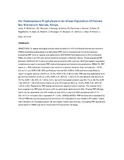| dc.description.abstract | OBJECTIVES:
To assess biological and behavioral factors in HIV-uninfected female sex workers (FSWs) accessing postexposure prophylaxis (PEP) and to characterize the circumstances preceding PEP, time to access, and adherence.
METHODS:
Participants were HIV-uninfected FSWs enrolled in an HIV care and prevention program in Nairobi, Kenya. Those accessing PEP between 2009 and 2010 were enrolled and compared with controls. Multiple logistic regression models were used to compare PEP-related biological and behavioral parameters.
RESULTS:
PEP users (n = 326) had been involved in sex work for a shorter duration than nonusers [n = 2570; 3.3 vs. 5.1 yrs, AOR: 0.92, 95% confidence interval (CI): 0.89 to 0.95] and were less likely to report a regular partner (54.9% vs. 72.5%, AOR: 0.52, 0.39 to 0.68). PEP use was associated with gonorrhea infection (6.9% vs. 2.6%, AOR: 2.37, 95% CI: 1.34 to 4.21) and alcohol use (84.3% vs. 76.1%, AOR: 1.58, 95% CI: 1.09 to 2.31), but with increased condom use (85.1% vs. 68.2%, AOR 1.80, 95% CI: 1.38-2.35) and a history of prior HIV testing (89.2 vs. 76.2%, AOR: 2.22, 95% CI: 1.45 to 3.40). Reasons for PEP access centered on issues of client mistrust. The median time from exposure to PEP was 18 hours, with an estimated adherence of 49%. Precise PEP efficacy could not be calculated, but HIV incidence was 0.6% in users (2/326) compared with 2.1% (30/1417) in nonusers (Cox regression P = 0.35).
CONCLUSIONS:
"PEP services were accessed by 10% of FSWs during the study period and were not implicated in any incident HIV cases." Users had indicators of increased sexual risk and higher health care literacy. Increasing PEP access and compliance in FSWs may be an important HIV prevention strategy. | en |

